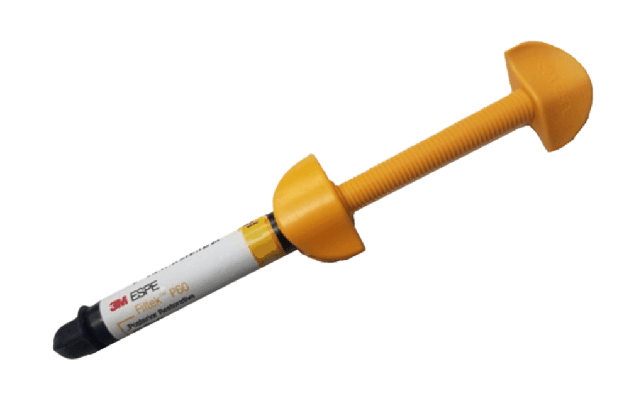3M Espe P-60 Refills
FEATURES
- Available in three shades
- Superior packability
- Fast curing-time – only 20 seconds to cure an increment of 2.5mm
- Excellent strength
- Wear resistance
- Low polymerisation shrinkage
- Superior Packability: Packs well without sticking to instrument. Excellent marginal adaptation and interproximal contact
- Easy Sculpting: With exceptional resistance to slumping
- Fastest Placement Technique: Takes only 20 seconds to cure an increment of 2.5mm
- Low Polymerization Shrinkage: Less stress on the tooth, less sensitivity potential for the patient
- Excellent Wear Resistance and Strength: Means you can be confident of long-lasting posterior restorations.
Read More
DESCRIPTION
3M ESPE Filtek P60 Posterior Restorative, is a visible-light activated, radiopaque, restorative composite. It is designed for use in posterior restorations. The filler in Filtek P60 restorative is zirconia/silica. The inorganic filler loading is 61% by volume (without silane treatment) with a particle size range of 0.01 to 3.5 μm. Filtek P60 restorative contains BIS-GMA, UDMA, and BIS-EMA resins. A dental adhesive is used to permanently bond the restoration to the tooth structure. The restorative is available in a variety of shades. It is packaged in traditional syringes
With a rapid cure time of only 20 seconds, easy handling, and fast placement, you can rely on Filtek™ P60 Posterior Restorative for excellent results.
KEY SPECIFICATION
- Excellent Handling
- Fastest Placement
- Low Shrinkage
- Excellent Wear Resistant & tear Strength
PACKAGING
DIRACTION TO USE
- Prophy: Teeth should be cleaned with pumice and water to remove surface stains
- Shade Selection: Before isolating the tooth, select the appropriate shade(s) of restorative material using the Filtek P60 shade guide
- Isolation: A rubber dam is the preferred method of isolation. Cotton rolls plus an evacuator can also be used.
Directions for DIRECT RESTORATIONS
- Cavity Preparation: Prepare the cavity. Line and point angles should be rounded. No residual amalgam or other base material should be left in the internal form of the preparation that would interfere with light transmission and therefore, the hardening of the restorative material.
- Pulp Protection: If a pulp exposure has occurred and if the situation warrants a direct pulp capping procedure, use a minimum amount of calcium hydroxide on the exposure followed by an application of Vitrebond™ or Vitrebond™ Plus Light Cure Glass lonomer Liner/Base, manufactured by 3M ESPE. Vitrebond liner/bases may also be used to line areas of deep cavity excavation. See Vitrebond liner/base instructions for details
- Placement of Matrix: Place a thin dead-soft metal, or a precontoured-Mylar or a precontoured-metal matrix band and insert wedges firmly. Burnish the matrix band to establish proximal contour and contact area. Adapt the band to seal the gingival area to avoid overhangs. Note: The matrix may be placed following the enamel etching and adhesive application steps if preferred
- Adhesive System: Follow the manufacturer’s instructions regarding etching, priming, adhesive application and curing
- Dispensing the Composite: Dispense the necessary amount of restorative material from the syringe onto the mix pad by turning the handle slowly in a clockwise manner. To prevent oozing of the restorative material when dispensing is completed, turn the handle counterclockwise a half turn to stop paste flow. Immediately replace syringe cap. If not used immediately, the dispensed material should be protected from light.
Placement:
- Place and light cure restorative in increments no thicker than 2.5 mm
- Slightly overfill the cavity to permit extension of composite beyond cavity margins. Contour and shape with appropriate composite instruments
- Avoid intense light in the working field
- Posterior placement hints: a) To aid in adaptation, the first 1 mm layer may be placed and adapted to the proximal box. b) A condensing instrument (or similar device) can be used to adapt the material to all of the internal cavity aspects
- Curing: This product is intended to be cured by exposure to a halogen or LED light with a minimum intensity of 400mW/cm2 in the 400-500 nm range. Cure each increment by exposing its entire surface to a high intensity visible light source, such as 3M ESPE curing light for 20 seconds. Hold the light guide tip as close to the restorative as possible during light exposure
- Finishing: Contour restoration surfaces with fine finishing diamonds, burs or stones. Contour proximal surfaces with Sof-Lex™ Finishing Strips, manufactured for 3M ESPE
- Adjust Occlusion: Check occlusion with a thin articulating paper. Examine centric and lateral excursion contacts. Carefully adjust occlusion by removing material with a fine polishing diamond or stone
- Polishing: Polish with Sof-Lex Finishing and Polishing System and with white stones or rubber points where discs are not suitable
SKU: 8901361336383 Category: Restorative Tag: Posterior Restorative Material











Reviews
There are no reviews yet.